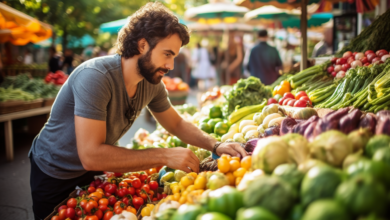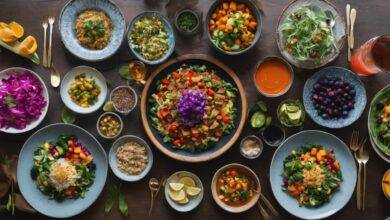19 Awesome Mediterranean Food Delights
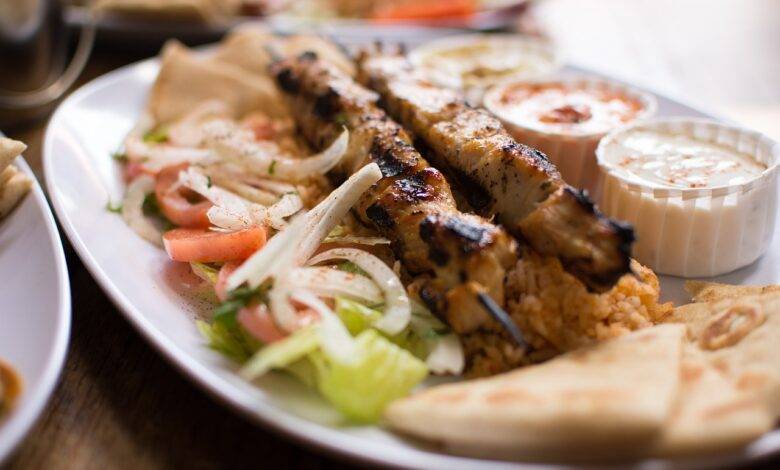
Mediterranean food is known for its distinctive flavours and healthy ingredients. It’s often associated with long-term weight loss and overall well-being. But there are many different types of Mediterranean cuisine, some of which you may not know about. Furthermore, the Mediterranean diet has been linked to a number of health benefits that can help you lose weight and keep it off.
Mediterranean Food: What Is It?
The Mediterranean diet is based on the traditional diets of Greece, Italy, Spain, Portugal, France, and other countries along the Mediterranean Sea. This type of eating pattern emphasises fresh fruits, vegetables, whole grains, legumes, nuts, olive oil, fish, poultry, and low amounts of red meat.
It’s also important to note that this diet doesn’t include any dairy products or processed foods. Instead, it focuses on unrefined carbohydrates like fruit, vegetables, beans, and whole grains. In addition, it includes moderate amounts of seafood, poultry, eggs, and cheese.
Health Benefits of consuming Mediterranean Food
The Mediterranean diet has been shown to reduce your risk of heart disease, diabetes, cancer, Alzheimer’s disease, depression, and more. Here are just a few of the ways that this diet helps improve your health.
a. Lowering Blood Pressure
A study published in the Journal of Hypertension found that people who followed a Mediterranean diet had lower blood pressure than those who didn’t. Other studies have shown similar results.
b. Losing Weight
In one study, researchers looked at data from over 1,000 adults. They found that participants who ate a Mediterranean diet lost an average of 4 pounds over two years, compared to 2 pounds among those who did not follow the diet.
c. Improving Brain Health
In another study, scientists examined how the Mediterranean diet affected brain function. The team studied over 200 older adults living in Spain. After following this dietary plan for three months, they found that those who adhered to the Mediterranean diet showed improvements in memory, attention, and executive functioning.
d. Reducing Risk of Heart Disease

A recent study found that people who ate a Mediterranean diet were less likely to get heart diseases like heart attacks and strokes.
e. Preventing Cancer
A review published in the journal Nutrition & Metabolism found that people who eat a Mediterranean diet are less likely to get breast cancer, colon cancer, prostate cancer, and lung cancer.
f. Boosting Immunity
According to a study published in the European Journal of Clinical Nutrition, people who eat a Mediterranean diet tend to be healthier because their immune systems work better.
g. Helping With Depression
Another study found that people who follow a Mediterranean lifestyle had fewer symptoms of depression.
h. Promoting Overall Wellness
People who follow a Mediterranean diet tend to live longer lives than those who don’t. A study published in the American Journal of Medicine found that people who adhered to the Mediterranean diet lived an average of 7.8 years longer than those who didn‘t.
i. Protecting Your Bones
Researchers believe that the Mediterranean diet protects against osteoporosis by improving bone density. Bone loss is common after menopause.
j. Maintaining Healthy Skin
Eating a healthy diet can help you maintain beautiful skin. According to the Mayo Clinic, eating a Mediterranean diet may help prevent wrinkles and other signs of ageing.
k. Fighting Inflammation
Research shows that inflammation plays a role in many chronic illnesses, including heart disease, arthritis, asthma, and even cancer. Eating foods high in antioxidants reduces inflammation while also helping with weight loss.
l. Filling You Up
The Mediterranean diet fills you up without adding too much fat or calories. In fact, it’s one of the most filling diets around. A study in the British Journal of Nutrition found that people who followed this type of diet consumed about 300 fewer calories per day on average.
19 Best Mediterranean Foods
The Mediterranean Diet is one of the healthiest diets around. It’s rich in fruits, vegetables, nuts, seeds, beans, whole grains, fish, olive oil, herbs, and spices. It’s low in red meat, processed foods, sugar, and salt. Eating this way can help you live longer, healthier and happier.
We’ve explored some practical reasons for enjoying Mediterranean foods to this point. So, look at some of the Mediterranean’s most enjoyed appetiser dishes.
Mediterranean Food – Appetisers
1 Mezze
The word “to taste” is where the term “mezze” originates from, and it comes from the Persian language.
Mezze is not a type of meal in and of itself; instead, it refers to a variety of little dishes, and appetisers served in various countries.
Turkish mezze can be found in a wide variety of mouth-watering flavours.
These are fried calamari, pepper and walnut sauce, and sliced melons.
Mezze dishes such as tabbouleh, hummus, and baba ghanoush are all trendy choices.
These are only a few examples from an extremely long list of foods. Dishes from the mezze menu that are particularly well-liked in Greece and Cyprus include fava beans and grilled cheese.
Mezze can mean two things, depending on the country or region where it is eaten. Mezze is a type of appetiser shared in Turkey, Greece, and the Balkans. It is typically offered at social gatherings while alcoholic beverages are drunk.
The variety of flavours in mezze goes well with a wide range of alcoholic drinks, such as Cyprus’s Rakia and brandy.
Mezze is the main meal in the Muslim parts of the Mediterranean, where drinking alcohol is not allowed.
2 Tapas

The Romans were the first known people to combine the serving of spreads and appetisers into one course.
But the tapas that we know and love today didn’t appear until the 18th century, when they were brought to Spain by innkeepers from France.
At that time, there were plenty of travellers staying at their inns. It was only natural for the innkeepers to want to provide them with meals.
However, the innkeepers had difficulty communicating with the travellers due to a lack of a common language and other obstacles.
Therefore, they would set up a table with a variety of snacks. In this manner, the travellers could choose what appealed to them.
Today, tapas can include flavours ranging from the lowest depths of the ocean to the highest peaks of the Alps.
Everyone can find something to their liking, whether it be smoked chorizo, battered squid, soft cheeses, or cold meats and cheeses.
Food from the Mediterranean region is about so much more than just nourishment. It plays a significant role in a variety of social activities as well as culture. Tapas bars are the perfect symbol for this in every way.
Mediterranean Food – Salads
3 Greek Salad
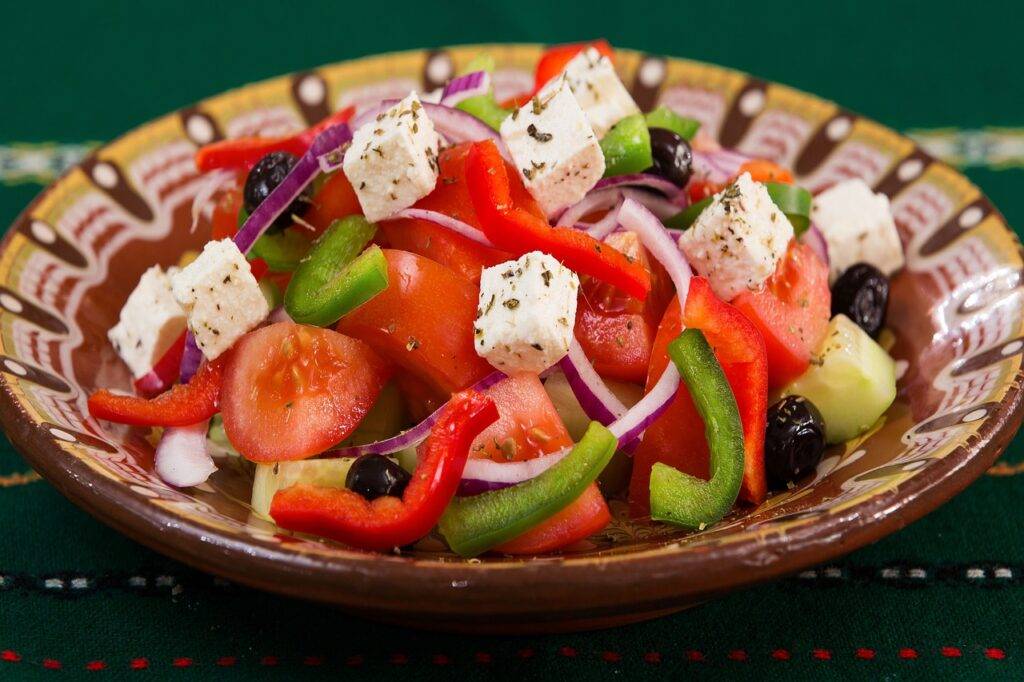
A Greek salad is the perfect food to enjoy throughout the summer. The Greeks have a fierce passion for feta cheese. Most people believe that tomatoes are required to make a Greek salad. But it doesn’t. There are, in point of fact, a great many distinct iterations of a Greek salad.
The Mediterranean region’s temperature is conducive to growing vegetables and fruit that are exceptionally ripe and delicious.
You need only stroll through the food market of a Greek, Turkish, or Italian country to be astounded by the enormous size of the fruit and vegetables and the brilliant colours they display.
In addition, if you want to survive the blazing heat, you should probably have a salad that is both cold and refreshing.
It’s been hypothesised that farmers in rural areas created the Greek salad to whip up a quick supper using the ingredients they already had on hand.
The typical ingredients in a Greek salad are tomatoes, cucumbers, bell peppers, and olives that have just been picked or bought at a local market.
The use of feta cheese distinguishes it. In the past, a slice of feta would be used to coat the various components of the salad. You can now find salads that have crumbled or cubed Feta on them.
If you add a lot of seasoning to the salad and drizzle it with olive oil, you will have the Greek salad, which is the cuisine’s heart and soul.
4 Fattoush Salad
One of the meals typical throughout the Middle East is Fattoush salad; you can find it just about anywhere. People who live in the area see it as their primary food source. This recipe can be prepared in many different ways. Still, most call for sliced cucumbers, tomatoes, onions, parsley, mint leaves, olives, and feta cheese. In some cases, pickled turnips are also used.
The way the components of each variety of Fattoush salad are arranged on the plate is the primary factor that differentiates them from one another. While some individuals want to put the toppings on the bread, others prefer to put them inside the bread or on top.
The origin of the word “fattoush” can be traced back to the Arabic verb fatt, which means “to crush.” Another illustration of the creativity of the Mediterranean can be found in the dish Fattoush.
It is said that farmers in Lebanon would collect whatever leftover pieces of pita bread they had lying around.
Afterwards, they would cook them in oil and then toss them with whatever vegetables they already had on hand in a salad.
This dish skyrocketed to unprecedented levels of fame across the Levant region. It can be found in many different forms across the several countries that make up the region.
In a traditional Fattoush salad made today, the cucumbers, lettuce, tomatoes, onions, and radish will all be finely diced and used.
Adding only a sprig of mint or a pinch of lemon zest to the warm dough and the fresh vegetables in the salad helps create an additional flavour layer.
5 Salade Nicoise
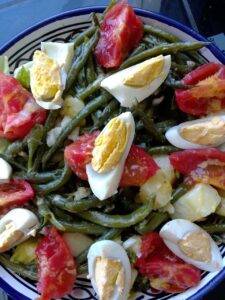
One of the most famous recipes to come out of France is the salade Nicoise. It is made of uncooked vegetables such as lettuce, tomato, cucumber, green beans, and eggplant. It can be topped with vinaigrette dressing. Even though it’s usually eaten hot, it’s often served at room temperature with cold meats like smoked salmon or ham.
This light and flavourful salad were first made so people with low incomes could eat it.
During the 1800s, the poorest people in Nice ate a dish made of tomatoes, anchovies, and olive oil that had been drizzled on top. It was easy to make and cheap.
After some time, the salad gained popularity in restaurants and began to evolve. By the turn of the century, the salad had grown to include various novel and exciting components.
To this day, the traditional Nicoise salad continues to be made with tomatoes, anchovies, and olives as its three main components.
This dish is an example of a tossed salad. It also includes a wide variety of fresh and crunchy vegetables, such as peppers and shallots.
The next step is to add small pieces of hard-boiled egg or a spread of tuna from a can. The dish is then heavily seasoned and drizzled with olive oil.
The salade Nicoise is a lovely dish that is great for a warm day in the Mediterranean. Many people refer to it as the “perfect summer salad.”
Mediterranean Food – Pastry
6 Pita Bread

Pita is one of the most well-known and cherished types of bread worldwide due to its airy consistency and calming flavour.
Since the dawn of time, Middle Easterners have been using this round flatbread made from wheat flour to wrap around various delicious treats.
Some of the oldest recorded flatbreads were baked, and these early loaves of bread were the ancestors of today’s pita.
It is indigenous to the region known as the Fertile Crescent, which is located in the Middle East and stretches from northern Egypt to the Persian Gulf.
However, it was the Greeks who were the ones who first popularised pita bread. In the 1930s, the word “pita” debuted in English for the first time.
Baking at extremely high temperatures, up to 475 degrees Fahrenheit, gives pita its signature “puffed” appearance because the water in the dough will turn into steam when it evaporates.
Because of this, it can serve as a tasty pocket for a wide variety of delectable items to be placed in it.
On the other hand, other cuisines, such as Greek food, favour the pita that does not have pockets. They bake it at lower temperatures, resulting in a flatter and more rounded pita.
When it comes to the culinary curriculum of the Mediterranean, pita is without a doubt the “cool kid.” It goes well with a wide variety of mouth-watering dishes.
Rich sauces such as hummus are a favourite condiment for dipping among Greeks. Kebabs are a popular dish in Turkey, and the people there load it full of tender cuts of meat.
It is the ideal bread for a filling breakfast in Palestine, which typically consists of hummus, pickled veggies, and falafel.
You will likely find pita utilised in a diverse assortment of mouth-watering meals no matter where your travels take you in the Mediterranean. Bread for all times of the year!
7 Borek
Borek was considered to be one of the most beloved food in Ottoman society. It is speculated that the name originates from the Turkish word bur, which means “to twist.”
And the winding, spiral form of this flavourful cooked pastry will be the first thing that catches your eye when you look at it.
Traditionally, either filo or yufka pastry can be used to make Borek. After baking in a huge pan, it is prepared for cutting into slices once it is done.
In some other parts of the Mediterranean, it is cooked in bite-sized pieces that are served individually.
Regarding the fillings, each country in the Mediterranean region has its own unique and delectable spin on this lovely meal.
In Turkey’s Su borei, a popular version, the layers of flaky pastry are filled with a smooth blend of feta cheese and parsley.
The typical breakfast fare in Armenia consists of stringy cheeses, cooked spinach, or ground meat. Even a sweet version of the Borek, packed with citrus flavours, has been developed in Greece.
The sphere of influence of Borek extends as far as West and Central Asia, even reaching as far as North Africa and the Balkans. Without a doubt, it is a traditional dish eaten by people in the Mediterranean.
8 Pizza Margherita
This is a dish that does not require any sort of introduction. However, suppose we want to keep loyal to the Mediterranean roots. In that case, we must journey back to Naples, Italy, in the 16th century.
Throughout history, a variety of toppings, including oil, tomatoes, and even fish, have been spread on the surface of flatbreads that were at the time referred to as “pizza.”
The diversity of dishes slowly evolved from what was once considered cuisine for the lower classes.
It is claimed that the first pizza Margherita was created by the skilled Neapolitan pizzamaker Raffaele Esposito in the year 1889. Margherita pizza was named after the queen of Naples.
He created a pizza with mozzarella cheese, tomatoes, and basil as the toppings to pay tribute to Margherita of Savoy. She was the Queen consort at the time.
White, red, and green are the three components selected to symbolise the colours associated with Italy.
In every region of Italy, you may get mouth-watering pizza. However, if you are able to make it to Naples, you are in for a real treat if you decide to order a traditional pizza that is baked in a stone oven.
Pizza Margherita combines a variety of flavours that are synonymous with the Mediterranean. A base made of nutritious wheat bread, veggies with a lot of moisture, creamy cheese, and olive oil.
Mediterranean Food – Vegetarian
9 Falafel

Everyone has a soft spot in their heart for falafel; it’s just one of those dishes. You have the option of making it yourself or purchasing it already made. It tastes best when accompanied by tahini sauce, pickled vegetables, and pita bread. This recipe for falafel, which is one of the most well-known delicacies in vegetarian cuisine, is straightforward and can be prepared in a short amount of time.
Falafel is a simple yet delicious meal. Each ball is comprised of mashed chickpeas that have been combined with various herbs and spices.
These bite-sized candies are formed into small patties by rolling them into balls. After that, they are fried in high-temperature oil and eaten either on their own or as part of a bigger meal or meze.
The history of falafel is not entirely clear. It is claimed that they originated in ancient Egypt as a straightforward snack that could stand in for meat when people were fasting.
In the traditional preparation of falafel, lava beans are used. However, by the time this dish reached the northern regions of the Middle East, chickpeas had already taken the place of lava beans.
In the cuisine of the Mediterranean, you’ll find them tucked away in crisp salads, stuffed into pita sandwiches, and served with a variety of flavourful dipping sauces, such as tahini.
10 Ratatouille
While the food of northern France is typically considered to be European, the cuisine of southern France more closely resembles that of the Mediterranean.
The meal known as ratatouille is traditionally said to have come from Nice in France. The first known recipes date from 1877, although the current formula didn’t become popular until the 1930s. Bread and cheese are traditionally included in the serving. Typical ingredients for ratatouille include tomatoes, onions, eggplant, green peppers, and potatoes. Ratatouille can also be made with zucchini. The word ratatouille, from which the meal gets its name, literally means “to stir like a chef,” where the dish gets its name.
The dish is most commonly linked with the Provence area of France and is regarded as one of the most important meals that can be found in the cuisine of Nice. In addition to being enjoyed all over France, it is also extensively consumed in Italy and Spain, making ratatouille a natural progression from these other cuisines. This flavourful vegetable stew is one of the things that sets French food apart from different cuisines, and it’s famous all around the world.
This ratatouille has a strong base made of tomato stew as its foundation. Eggplant, bell peppers, and zucchini cut into chunks or slices bring brilliant colours and a variety of fresh flavours to the dish.
Garlic and onions are added to the stew in significant quantities as well. After that, a variety of other herbs, including basil, thyme, and others, are used to season the soup.
Old-school Cooking the veggies separately before combining them in one large pot is widely held to be the original method of preparing ratatouille, particularly among French chefs.
The Ratatouille recipe calls for a low and slow cooking time to get the desired velvety consistency. This makes it possible for the flavours to permeate the liquid as well.
Ratatouille is a classic dish of the Mediterranean because of its history and the vegetables it uses.
11 Mediterranean Risotto
Risotto is one of those recipes that is popular among a wide variety of people. You are free to use practically any ingredient you like in its preparation. In point of fact, it has a good deal of adaptability. Risotto is a dish that has been consumed for generations and is known for being both simple and nourishing despite its richness. It comes from northern Italy.
The broth in which the rice is cooked is an essential component of risotto. Both should be cooked together until they reach a more thick and creamy consistency.
Over the course of time, a wide variety of risotto flavours have been developed and perfected.
Rice, parmesan cheese, onions, wine, and butter are often cooked together in the broth while making a traditional risotto dish.
It is said that an apprentice chef in Italy in the 19th century added saffron to a rice dish that was being served at a high-status wedding.
According to the legend, this dish was the first instance of what we now refer to as “risotto.”
Risotto is now available in a wide variety of flavours and tastes to suit a variety of preferences. Risotto with Fungi is a special dish served in many Italian restaurants.
Mediterranean Foods – Meat & Vegetables
12 Dolmas
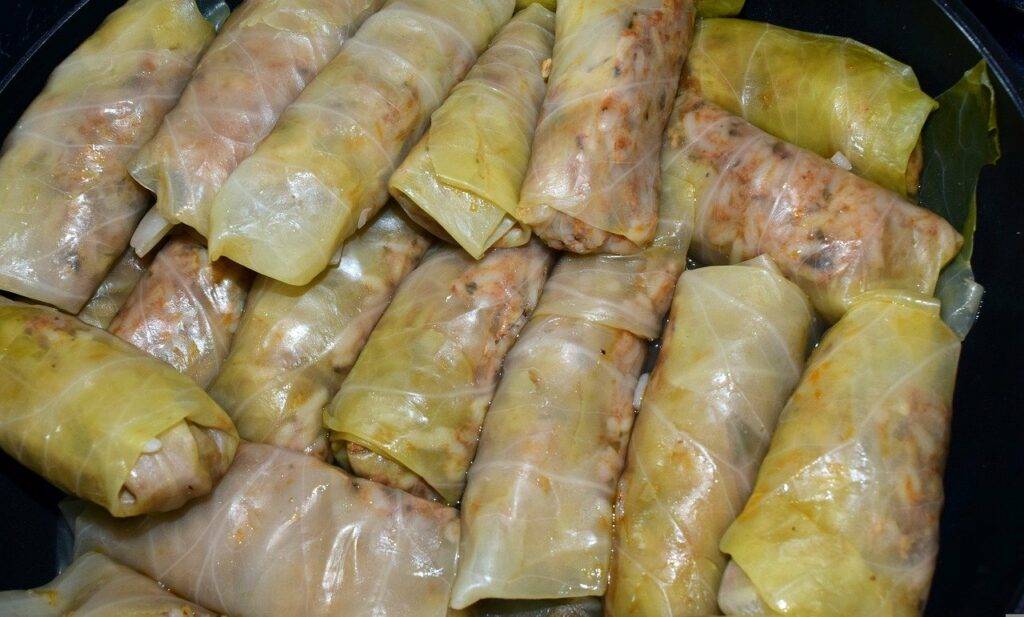
The word “dolma” comes from a Turkish word meaning “meat stuffed.” This age-old recipe has been passed down through the generations for thousands of years. Dolmas are thought to have originated in ancient Greece, a region where meat was scarce at the time. After that, they were sent to Turkey, where the nomadic peoples of that country quickly took a liking to them. Dolmas are a popular food in many parts of the world today, including the Middle East, North Africa, Central Asia, Eastern Europe, and South America.
Dolmas can be made with various fillings, including beef, lamb, chicken, turkey, fish, vegetables, or fruit. There are multiple varieties of dolma. The preparation of each distinct type of dolma differs according to the kinds of fillings that are used. While some people like to wrap the filling in grape leaves, others opt to wrap it in pita bread instead. Dolmas are incredibly versatile and may be made with almost any filling. You could, for instance, stuff them with rice, lentils, potatoes, spinach, cheese, olives, or any number of other things.
The dolma family of meals is one of the most important in all of Mediterranean cuisine. Since ancient times, people have been stuffing vegetables with various hearty meals as a culinary technique.
Arabic cookbooks have written documentation of recipes for stuffed vegetables that date back long before the Ottoman Empire.
Dolmas are interpreted significantly different across the many countries that comprise the East Mediterranean and Middle Eastern areas.
In Turkey, you can find vivid roasted eggplant that is packed with ground lamb and sturdy rice, seasoned with a rich blend of spices and finished with a splash of lemon.
For this dish, peeled onions are stuffed with ground beef, rice, copious amounts of spice, and sour cream before being baked.
To the east, in countries such as Syria, Iraq, and Armenia, you can find balls of rice flavoured with cinnamon and other spices and then wrapped in vine leaves.
Dolma is one of the foods that originated in the Mediterranean region and is considered to have a significant historical impact. This demonstrates how creative and resourceful one can be with even the most basic of ingredients.
13 Moroccan Tagine
A Moroccan tagine is an old Mediterranean dish that originated in Morocco, where it’s still prevalent today. This recipe uses a combination of vegetable and fruit ingredients, giving it a unique flavour profile, and it’s made with lamb, making it a hearty and filling stew.
The word “tagine,” on the other hand, relates not to the components of the dish but rather to the manner in which it is prepared: in a broad and shallow pot heated over a high flame.
The origins of tagine can be traced back to the 9th century, during the reign of the Arab king Harun al-Rashid and his army, who overran a large portion of North Africa and the Levant.
The term “tajine” is used to describe a wide variety of dishes from Morocco, including both meat-based and vegetarian preparations. The combination of savoury and sweet flavours is what gives tagine its irresistible appeal.
Spices are abundant in a Moroccan tagine. Cinnamon, saffron, and ginger are just a few of the many flavours that are frequently used in the preparation of these dishes.
The combination of indigenous fruits with traditional savoury components is another popular trend. One of the most conventional combinations for a Moroccan tagine is tender lamb with dried fruits like prunes or apricots.
14 Moussaka
During the 1920s, Greek cuisine was responsible for the widespread dissemination of this baked casserole consisting of eggplant and ground beef.
On the other hand, it may trace its roots all the way back to the Levant. Turkey, Lebanon, and Israel are just some of the countries that are located in this area to the east of the Mediterranean Sea.
Lamb is combined with sautéed eggplant and ripe tomatoes in the traditional recipe, which results in a dish that is both flavourful and juicy. There are many variations of moussaka, depending on where you live. In Cyprus, for instance, there is a version called “Kozina” that contains spinach.
Nikolaos Tselementes, a Greek chef, trained in France, is credited with elevating moussaka to the status of one of the most well-known meals to come out of Greece.
His method of layering moussaka is still widely utilised as the basis for the dish today.
The bottom layer often consists of alternating layers of eggplant and a generous amount of olive oil.
The centre layer is the meat layer, coupling minced lamb with a selection of tasty veggies and seasonings.
The moussaka is finished off with a coating of white sauce, also known as béchamel, which pulls everything together. Nikolaos Tselementes would first prepare each of the three layers independently before combining them in the oven.
Tselementes included the traditional French Béchamel sauce in the meal as a way of attempting to remove the Turkish influence that was there at the time because Greece was under Turkish domination.
15 Mediterranean Shakshuka
Tajima is an earthenware clay dish that is traditionally used to prepare Shakshuka. Tajima is also the name of the meal. Around the world, there are a significant number of distinct variants. Rice or couscous is a common accompaniment.
Poached eggs are elevated to an entirely new level when transformed into Shakshuka, a dish that is thought to have been brought to the Mediterranean by Jews from Tunisia.
The foundation of Shakshouka is a ripe and rich base sauce that is prepared by combining ripe tomatoes, peppers, onions, and a generous amount of olive oil in a blender.
Spices are abundant, as they are in many of the cuisines from North Africa. In the sauce, paprika, nutmeg, cumin, and black pepper all play a significant role in the flavour profile.
On top of this simmering stew, eggs that have been poached are placed. These eggs are heavily seasoned with a variety of spices so that the flavour is brought out even more.
Since ancient times, people in the Middle East have been consuming stews made with tomatoes in a similar fashion. Shakshuka was prepared in a significant number of different ways across the Ottoman Empire.
It is traditionally served in a cast-iron skillet, which is reminiscent of a tagine. This helps to maintain the Shakshuka at a comfortable temperature while you consume it.
16 Ful Medames
A meal called ful medames has its origins in ancient Egypt and dates back millennia. It was a staple cuisine in Egypt, and Egyptians continue to eat it to this day. In point of fact, it is one of the dishes that is consumed the most frequently throughout the month of Ramadan. Small balls of dough are used to make ful medames, which are then stuffed with meat, vegetables, spices, herbs, and nuts. Salt is typically put on them after they have been fried in oil.
Food from Egypt may nearly always be identified by the presence of fava beans in the dish. A popular dish in Egypt is known as Ful Medames.
In its most basic form, Ful Medames is a stew made with fava beans. However, this nutritious staple comprises much more than simply mouth-watering fava beans by themselves.
In Ful Medames, you’ll often find a variety of different flavours. There is enough of a kick, thanks to the tangy taste of lemon juice and the fiery heat of chilli peppers.
Along with the other veggies, cumin, garlic, parsley, and onion are some of the ingredients that are added to the stew.
After being cooked, Ful Medames goes well with a variety of different kinds of sides.
The Egyptians love to eat this stew with a variety of different toppings, including cured beef, hard-boiled eggs, and vegetable oil.
It is believed that the basic recipe has seen very little change since it was first employed in ancient Egypt.
Naturally, this uncomplicated but nourishing stew spread throughout North Africa and eventually made its way to the Middle East. It’s popular in a lot of different countries.
17 Mediterranean Paella
One of the dishes that is considered to be the national dish of Spain is paella. It is a traditional dinner that is served at festive events such as weddings and baptisms, and it often consists of meat and vegetables. Paella is not only delicious, but it is also quite good for you because it contains a great deal of seafood and vegetables.
This recipe calls for items that can be found in most supermarkets in Spain. Saffron, chorizo, potatoes, tomatoes, and peas are some of the additional ingredients that may be found here. In addition, you won’t need to invest in any pricey kitchenware in order to prepare this dish. You will just want a large stockpot and a few cooking tools for this recipe.
Delicious meat and vegetables are combined with a distinct variety of rounded rice, which is characteristic of the paella recipe. Paella is a Spanish dish.
Middle Eastern settlers were the ones who brought this variety of rice to Spain in the 10th century, the same way that they brought many other types of Mediterranean dishes.
But the paella that we adore and are familiar with today wasn’t invented until much later. It is possible to trace its roots all the way back to the 19th century and the rural districts that surrounded Valencia.
The allure of paella lies in the manner in which it is prepared. The components are prepared by slowly cooking them in a circular pan that is relatively shallow over an open fire.
The servings of paella can be monstrous in proportions. It is the ideal supper for huge Spanish family gatherings and other occasions where there are a lot of people to feed.
Rice that has been cooked in copious amounts of olive oil turns out crisp and golden in colour. The recipe calls for both saffron and rosemary to be used as seasonings.
In the past, traditional recipes called for tender pieces of rabbit, chicken, or duck. Due to Valencia’s proximity to the coast, the consumption of fish has become familiar over time.
This particular brand of paella, which includes the cooking of seafood items like mussels and shrimp in addition to other well-liked meats like chorizo, has gained an enormous amount of popularity.
Mediterranean Deserts & Wine
18 Baklava
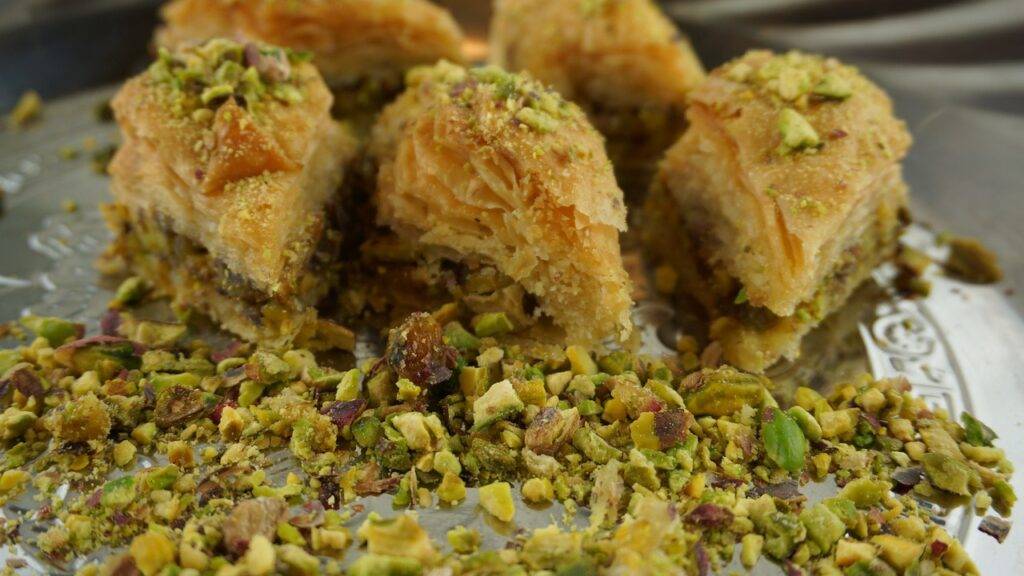
The name “baklava” comes from the Greek language, and the literal translation of the phrase is “flaky pastry.” Baklava is a type of pastry. This dish, which originated in Turkey during the time that it was ruled by the Ottoman Empire, is considered to be one of the most famous pastries in Turkey. Typically, it is cooked in big round sheets known as filo, which are then loaded with almonds and honey and covered with powdered sugar before being baked.
The layers of pastry that makeup baklava have a texture similar to that of flaky pie crust and butter. This crunch, when coupled with the syrupy, sugary consistency of the honey, makes for a mouth-watering morsel.
The most frequent types of nuts consumed in Turkey and Greece are pistachios and walnuts. However, a wide variety of other pulverised nuts have been utilised in the preparation of baklava.
After a meal on a warm Mediterranean evening, this slice of heaven, which is best served cold, is the perfect way to round off the meal.
19 Wine
Wine is an integral part of Mediterranean cuisine. In fact, there are many stories about how wine helped save ancient civilisations. The Romans believed that drinking wine during battle could increase courage and help soldiers win wars. They even had a special day called Vinaria, where they celebrated the victory over the Gauls. Today, we still celebrate Vinaria every year. However, most people do not realise that wine is actually one of the oldest drinks known to man. Archaeologists believe that humans began producing wine around 10,000 BC.

Mediterranean Food, start making changes to what you eat.
The Mediterranean diet is a way of eating based on the traditional cuisine of countries bordering the Mediterranean Sea. This includes Greece, Italy, Spain, France, Turkey, Morocco, Lebanon, Syria, Israel, Egypt, Cyprus, Malta, Tunisia, Algeria, Libya, and Portugal. There are many different variations of the Mediterranean diet, some of which include fish, vegetables, fruits, nuts, seeds, olive oil, whole grains, legumes, dairy products, poultry, eggs, wine, and red meat.
This diet has been linked to lower rates of heart disease, diabetes, cancer, obesity, arthritis, depression, dementia, Alzheimer’s, and Parkinson’s disease. In addition, people who follow the Mediterranean diet tend to live longer lives.
Mediterranean Food FAQ
What foods are Mediterranean food?
The traditional foods of Greece, Italy, and other nations bordering the Mediterranean Sea are the foundation of the Mediterranean diet, which is an eating plan. The basis of the diet is composed primarily of plant-based foods, such as whole grains, vegetables, legumes, fruits, nuts, seeds, herbs, and spices.
What culture eat Mediterranean food?
Although there are many dishes that can be identified as being from the Mediterranean, true Mediterranean cuisine actually encompasses the entire Mediterranean basin, which includes many very different geographical regions, including Spain, Italy, Greece, Egypt, Turkey, and Syria, among others.
Is Mediterranean food and Greek food the same?
The term “Mediterranean food,” which refers to the cuisine of all the Mediterranean nations, includes Greek cuisine. In a nutshell, it is Mediterranean cuisine with traits and components typical of other Mediterranean nations, such as Spain, Italy, Turkey, Malta, Lebanon, etc.


